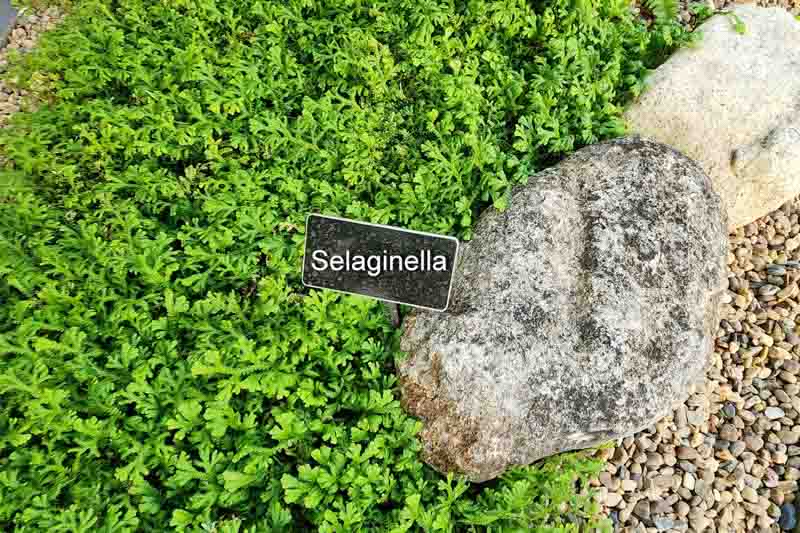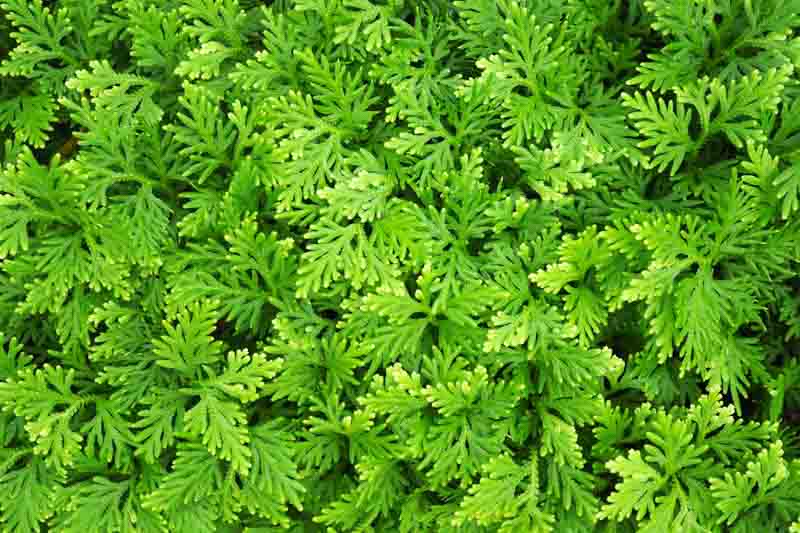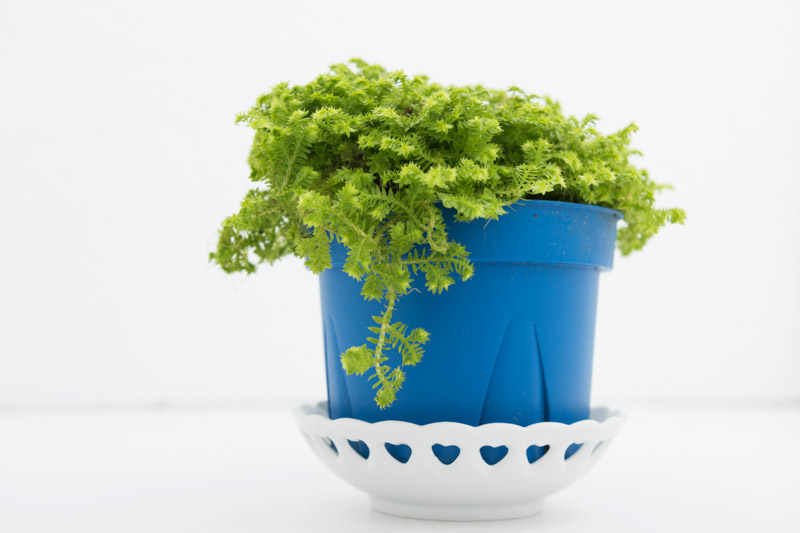African Clubmoss, Club Moss, Cushion Moss, Irish Moss, Japanese Moss, Krauss' Spikemoss, Mat Spike Moss, Moss Fern, Spikemoss, Spreading Club Moss, Trailing Irish Moss, Tropical Moss, Selaginella azorica, Selaginella canescens
Selaginella kraussiana, commonly known as Club Moss or Spike Moss, is a fascinating, ground-hugging plant cherished for its lush, vibrant green, moss-like appearance. This perennial plant is not a true moss but a primitive vascular plant, showcasing the diversity and complexity of plant evolution.
Selaginella kraussiana forms dense mats of delicate, feathery foliage. Its small, bright green leaves are intricately arranged on slender, creeping stems that root at the nodes, facilitating its spreading habit.
Native: Originally from the Azores and parts of Africa, it has adapted to various climates worldwide, primarily thriving in moist, shaded environments. It belongs to the spike moss family (Selaginellaceae).
Plant Type and Habit: Club Moss is a vigorous evergreen perennial prized for its mat-forming growth, creating lush carpets of greenery. It’s a non-flowering plant, relying on spores for reproduction, similar to ferns and true mosses.
Size: Typically, it reaches 2-4 inches in height (5-10 cm) and 12-18 inches in spread (30-45 cm).
Foliage: Its vibrant green foliage is the main attraction, providing year-round color and texture. The small, scale-like leaves are oval, with a slightly curled appearance, giving it a soft, feathery look.
Hardiness: Selaginella kraussiana is hardy in USDA zones 11-12 and tolerates high humidity. In cooler climates, it’s often grown as an indoor plant.
Award: Recipient of the prestigious Award of Garden Merit of the Royal Horticultural Society.
Uses: Club Moss is popular in terrariums, as ground cover (tolerates light foot traffic) in shaded gardens, and in hanging baskets where its foliage can cascade beautifully. It’s also used in holiday decorations and model railroading for its moss-like appearance.
Toxicity: It’s generally considered non-toxic to pets and humans, making it safe for households.
Invasiveness: Selaginella kraussiana can become invasive in some areas, spreading rapidly under ideal conditions. Due to its tendency to spread aggressively, it has been designated an invasive species under the New Zealand National Pest Plant Accord. Widely established in various regions of New Zealand and Australia, it thrives in shaded environments, where it forms extensive, dense mats, often outcompeting native flora. It’s essential to monitor its growth and control its spread in gardens.
Benefits: Its main benefits include soil stabilization in shaded areas, adding lushness to garden beds and terrariums, and requiring minimal care once established.

Growing and caring for Selaginella kraussiana can be a rewarding experience due to its lush, verdant appearance. Here’s a guide on how to care for this plant both indoors and outdoors:
Light: Selaginella kraussiana prefers bright, indirect light. Avoid direct sunlight, which can scorch its delicate leaves. A north or east-facing window is ideal.
Water: Keep the soil consistently moist but not waterlogged. This plant loves humidity, so consider placing it on a pebble tray filled with water or using a humidifier to maintain high humidity levels.
Soil: Use a well-draining, peat-based potting mix. A mixture of peat moss with perlite or vermiculite works well to ensure the soil stays moist but not soggy.
Temperature: It prefers cooler temperatures, ideally between 60-75°F (15-24°C). Avoid placing it near heat sources or in areas with drastic temperature changes.
Humidity: High humidity is crucial. Aim for 60% or higher, which can be achieved with regular misting, a humidifier, or placing it in a naturally humid room like a bathroom.
Light: Plant in a shaded or partially shaded area. It thrives under the canopy of larger plants or trees where it can receive filtered sunlight.
Soil: Outdoors, it prefers rich, organic, well-draining soil. Amending garden soil with compost and peat moss can help achieve the right conditions.
Water: Ensure the soil remains moist, especially in dry conditions. Mulching around the plant can help retain soil moisture.
Hardiness: It’s hardy in USDA zones 11-12. In colder regions, it should be grown in containers that can be brought indoors or treated as an annual.
Feeding: Feed with a diluted, balanced, liquid fertilizer during the growing season every 4-6 weeks. Avoid over-fertilizing, which can harm the plant.
Pruning: Trim back any brown or damaged fronds to encourage healthy growth and maintain a neat appearance.

Propagating Club Moss is relatively simple and can be done through division or stem cuttings. Here’s how to propagate this lush, carpet-forming plant:
This method is best performed in the spring or early summer when the plant is actively growing.
Gently Remove the Plant: Carefully lift the Selaginella kraussiana from its pot or garden location, trying to keep the root ball intact.
Identify Natural Divisions: Look for natural separations or clusters within the plant. These are areas where the plant can be divided with minimal stress.
Divide: Using your hands or a clean, sharp knife, gently separate the plant into two or more sections, ensuring each division has a portion of the root system attached.
Repot/Replant: Plant each division into its pot or a new location in the garden. Use a well-draining soil mix similar to the parent plant’s conditions, and ensure pots have good drainage.
Water Gently: Water the newly potted divisions lightly to settle the soil around the roots and remove air pockets. Keep the soil consistently moist but not waterlogged.
Stem cuttings are an efficient way to propagate Club Moss and can be done alongside division or as a standalone method.
Cut Stems: Select healthy, vigorous stems and cut them into 2-4 inch lengths. Ensure each cutting has several leaves or nodes.
Prepare for Planting: Fill a pot or tray with a moist, well-draining potting mix. You can use a mix of peat moss and perlite or sand to mimic the plant’s natural growing conditions.
Plant Cuttings: Stick the cuttings into the soil, ensuring at least one node (preferably more) is buried beneath the soil surface. The nodes are where roots will develop.
Maintain Humidity: Cover the pot with a plastic bag or place it in a propagator to maintain high humidity, which is crucial for root development. Make sure to ventilate occasionally to prevent mold growth.
Care After Rooting: Keep the cuttings in bright, indirect light and ensure the soil remains moist. Roots typically develop in a few weeks. Once rooted, you can remove the plastic covering and continue to grow the plants as usual, gradually acclimating them to less humid conditions.

Club Moss, while generally resilient and easy to care for, can still face its share of pests, diseases, and common problems, especially when not grown in optimal conditions.
Fungus gnats: These pests are attracted to moist soil and can be problematic for Club Moss. They typically don’t damage the plant directly, but their larvae can harm the roots. Allowing the soil surface to dry slightly between waterings and using yellow sticky traps can help control their population.
Mealybugs and Aphids: These sap-sucking pests can occasionally infest Club Moss, especially under stress or in poor ventilation. They can be identified by their presence on the stems or undersides of leaves. Treat infestations with insecticidal soap or neem oil, ensuring to reach hidden parts of the plant.
Root rot: Overwatering is a common issue with Selaginella kraussiana and can lead to root rot, characterized by yellowing leaves and a general decline in plant health. Ensure good drainage in the pot and avoid letting the plant sit in waterlogged soil.
Mold and Mildew: High humidity and poor air circulation can encourage the growth of mold and mildew on the plant and the soil surface. Improving air circulation and reducing surface moisture can help prevent these issues.
Brown Leaf Tips: This can occur due to low humidity, underwatering, or the accumulation of minerals from tap water. Using distilled or rainwater and increasing humidity can help prevent this issue.
Sparse Growth: If your Club Moss is not as lush or dense as desired, it might not be receiving enough light or moisture. While it thrives in indirect light, too much shade can hinder its growth. Similarly, inconsistent watering can stress the plant, affecting its density.
| Hardiness |
11 - 12 |
|---|---|
| Plant Type | Houseplants, Perennials |
| Plant Family | Selaginellaceae |
| Exposure | Partial Sun, Shade |
| Season of Interest |
Spring (Early, Mid, Late) Summer (Early, Mid, Late) Fall Winter |
| Height |
2" - 4" (5cm - 10cm) |
| Spread |
1' - 2' (30cm - 60cm) |
| Spacing |
12" - 18" (30cm - 50cm) |
| Maintenance | Low |
| Water Needs | Average |
| Soil Type | Loam |
| Soil pH | Acid, Neutral |
| Soil Drainage | Moist but Well-Drained |
| Characteristics | Showy, Evergreen, Plant of Merit |
| Tolerance | Rabbit, Full Shade |
| Garden Uses | Ground Covers, Hanging Baskets, Patio And Containers |
| Garden Styles | Gravel and Rock Garden |
| Hardiness |
11 - 12 |
|---|---|
| Plant Type | Houseplants, Perennials |
| Plant Family | Selaginellaceae |
| Exposure | Partial Sun, Shade |
| Season of Interest |
Spring (Early, Mid, Late) Summer (Early, Mid, Late) Fall Winter |
| Height |
2" - 4" (5cm - 10cm) |
| Spread |
1' - 2' (30cm - 60cm) |
| Spacing |
12" - 18" (30cm - 50cm) |
| Maintenance | Low |
| Water Needs | Average |
| Soil Type | Loam |
| Soil pH | Acid, Neutral |
| Soil Drainage | Moist but Well-Drained |
| Characteristics | Showy, Evergreen, Plant of Merit |
| Tolerance | Rabbit, Full Shade |
| Garden Uses | Ground Covers, Hanging Baskets, Patio And Containers |
| Garden Styles | Gravel and Rock Garden |
How many Selaginella kraussiana (Club Moss) do I need for my garden?
| Plant | Quantity | |
|---|---|---|
| Selaginella kraussiana (Club Moss) | N/A | Buy Plants |
Create a membership account to save your garden designs and to view them on any device.
Becoming a contributing member of Gardenia is easy and can be done in just a few minutes. If you provide us with your name, email address and the payment of a modest $25 annual membership fee, you will become a full member, enabling you to design and save up to 25 of your garden design ideas.
Join now and start creating your dream garden!
Create a membership account to save your garden designs and to view them on any device.
Becoming a contributing member of Gardenia is easy and can be done in just a few minutes. If you provide us with your name, email address and the payment of a modest $25 annual membership fee, you will become a full member, enabling you to design and save up to 25 of your garden design ideas.
Join now and start creating your dream garden!